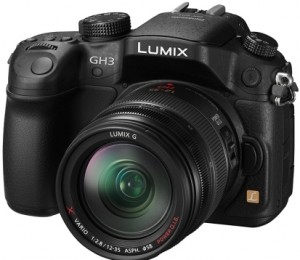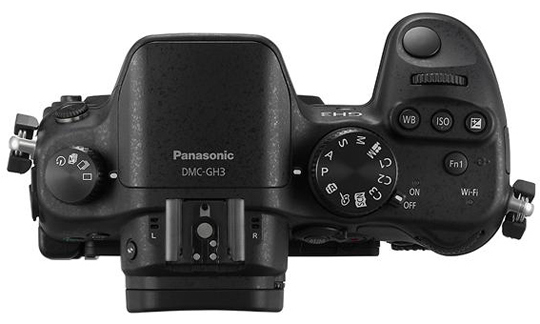
$1,299.00 w/o lens
The Panasonic GH2 just got a new brother. The Panasonic GH3. This is a Digital Single Lens Mirrorless (DSLM) camera. Here are the differences between it and the GH2.
The first thing you will notice is that is it bulkier than the GH2. Most early previewers think this makes it easier to use. The camera has a magnesium-alloy frame and is sealed against dust and water. It has an improved sensor and the ISO range has increased to 12,800 which can be boosted to 25,600 so this will be a good low light camera.
The GH3 can capture video at 60p compared to the 60i /30p of the GH2. The GH3 has a very fast 72Mbps bit rate. There’s now a 3.5mm headphone socket. One of the big differences is that it can shoot in MOV as well as AVCHD and MPG4. Shooting in MOV means it can capture files natively as 30p, as well as 60i. With MOV it can be edited directly in FCP. There is also the choice of All-I or IPB compression (more of which later in the preview), both will improve the video.
The mike input is now 3.5mm rather than 2.5mm. The GH3 has an added control dial on its top plate and the control layout is much easier to use.
This has the same touchscreen features as the GH2, but this one also has more direct buttons on the camera itself. Auto Focus options are now moved to the touchscreen. There are now five function buttons on the body itself which can be assigned different functions.

GH3 compared to GH2
- Improved sensor and processor
- Weather sealed magnesium alloy body
- OLED EVF and rear display (compared to LCD)
- 60p video capture (compared to 60i /30p)
- 72Mbps bit rate maximum (compared to 24Mbps)
- 3.5mm mic socket (rather than 2.5mm)
- 3.5 mm Headphone socket
- 6 fps continuous shooting (compared to 5fps)
- 5 custom Function buttons (compared to 3)
- Second control dial
- HDR and multiple exposure modes
- SMPTE Time Code
- Body is designed for rapid heat dissipation for extended shooting
- When recording the video in MOV, AVCHD Progressive and AVCHD, it automatically generates multiple
seamless files for continuous recording
For DSLRs, this looks like the best.






Very cool. We are anxiously awaiting this camera.
I understand Panasonic is shipping the GH3 now.
I am shooting with the GH3 on vacation in Hawaii. I have never had a DSLR (or SLR for that matter).
The camera seems to do what I ask it to do. It took me less than one day of shooting to go from full auto to full manual – to include manual focusing. I have taken some really bad photos. However I have taken some pretty decent shots and a couple of fantastic shots that will be a part of my permanent collection.
I can recommend this camera to someone who is used to shooting video with a good camcorder and wants to continue to shoot video, but who also wants to shoot photographs.
I watched hours and hours of photography tutorials before I ever shot a single photo so I had a feel for what I wanted to do. The GH3 is letting me do what I want. Of course, what I want often ends up being a bad idea, but it lets me do it.
I have yet to be in a situation where full auto is going to do the job, but I expect that if I had the camera in my hands everywhere I went, the opportunity to use full auto would present itself.